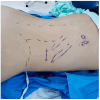Single-Port Robotic Posterior Retroperitoneoscopic Adrenalectomy: Current Perspectives, Technical Considerations, and Future Directions
- PMID: 40217764
- PMCID: PMC11989322
- DOI: 10.3390/jcm14072314
Single-Port Robotic Posterior Retroperitoneoscopic Adrenalectomy: Current Perspectives, Technical Considerations, and Future Directions
Abstract
Single-port (SP) robotic posterior retroperitoneoscopic adrenalectomy (SP-PRA) represents a State-of-the-Art innovation in endocrine surgery, offering a minimally invasive approach for adrenal gland resection with significant improvements in surgical precision, cosmetic outcomes, and patient quality of life. The SP robotic system facilitates surgery through a single incision in the back, avoiding the transperitoneal cavity and enabling direct retroperitoneal access to the adrenal gland. This review explores the evolution, techniques, and clinical outcomes of SP-PRA, emphasizing its advantages over traditional multi-port and laparoscopic methods. Enhanced visualization and precise articulation of the SP robotic system minimize trauma to surrounding tissues, leading to fewer complications and faster recovery times. Initial studies suggest superior patient satisfaction due to hidden incisions and excellent postoperative outcomes. However, challenges such as a steep learning curve, high costs, and limited long-term data remain. This review highlights the need for continued research and innovation to optimize the adoption of SP-PRA and expand its indications.
Keywords: minimally invasive surgery; retroperitoneal adrenalectomy; robotic surgery; single-port robotic system.
Conflict of interest statement
The author declares no conflicts of interest.
Figures
Similar articles
-
Robot-assisted posterior retroperitoneoscopic adrenalectomy using single-port access: technical feasibility and preliminary results.Ann Surg Oncol. 2013 Aug;20(8):2741-5. doi: 10.1245/s10434-013-2891-z. Epub 2013 Mar 14. Ann Surg Oncol. 2013. PMID: 23494081
-
The evolution and clinical impact of single-port transaxillary robotic thyroidectomy: a comprehensive review.Gland Surg. 2025 Jan 24;14(1):74-81. doi: 10.21037/gs-24-409. Epub 2025 Jan 9. Gland Surg. 2025. PMID: 39958894 Free PMC article. Review.
-
Contemporary Practice in Adrenal Surgery: A Review of Multiport versus Single-port and Transperitoneal versus Retroperitoneal Approaches.Eur Urol Focus. 2025 Jan;11(1):26-28. doi: 10.1016/j.euf.2025.05.004. Epub 2025 May 13. Eur Urol Focus. 2025. PMID: 40368722 Review.
-
Laparoendoscopic single-site retroperitoneoscopic adrenalectomy: bilateral step-by-step technique.Surg Endosc. 2017 Aug;31(8):3351-3352. doi: 10.1007/s00464-016-5400-1. Epub 2017 Feb 23. Surg Endosc. 2017. PMID: 28233094
-
Robotic-assisted retroperitoneoscopic adrenalectomy: making a good procedure even better.Am Surg. 2013 Jan;79(1):84-9. Am Surg. 2013. PMID: 23317617 Clinical Trial.
References
-
- Kim K. Various Methods for Laparoscopic Adrenalectomy. J. Endocr. Surg. 2023;23:1–6.
-
- Ko O.S., Kim J.Y., Kim H.J., Jeong Y.B. Laparoscopic partial adrenalectomy: Surgical technique and outcome. Korean J. Urol. Oncol. 2019;17:103–109.
Publication types
LinkOut - more resources
Full Text Sources
Research Materials



